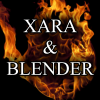My apologies if this is not the right place for this post, I'm not sure exactly where to ask this.
Inspired by some of the Xara/Blender creations posted by James I decided to see if I could manage to learn to use Blender and see if I could create something.
To start I'd like to ask about importing my xara work into Blender, and how to use it once I have it in there. I am sure I will have more questions along the way, already I am finding blender's learning curve much steeper than Xara's.




 Reply With Quote
Reply With Quote





 Both of the textures were created in Xara.
Both of the textures were created in Xara.
Bookmarks